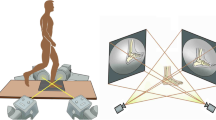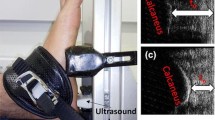Abstract
The shock absorbing characteristics of the heel pad in vivo were examined in two groups of active elderly individuals whose ages ranged between 60 and 67 years (n = 10) and between 71 and 86 years (n = 10). For comparative purposes, young adults (n = 10) aged between 17 and 30 years were also examined. A free-fall impact testing device which consisted of an instrumented shaft (mass 5 kg), accelerometer and position detection transducer was used to obtain deceleration and deformation of the heel during impact. The data were obtained from impact velocities of 0.57 m · s−1 (slow) and 0.94 m · s−1 (fast). Peak values of the deceleration and deformation, as well as the time to these peaks from onset of impact, and energy absorption were evaluated. At the slow impact velocity, no age effect was found for the parameters examined except for the energy absorption. At the fast impact velocity, there was higher peak deceleration and smaller deformation for the elderly than for the younger adults. The energy absorbed was less for the elderly than for the younger adults. It was concluded that the capacity for shock absorbency of the heel pad declines with age.
Similar content being viewed by others
References
Aerts P, De Clercq D (1993) Deformation characteristics of the heel region of the shod foot during a simulated heel strike: the effect of varying midsole hardness. J Sports Sci 11:449–461
Alexander R, McN Bennett BM, Ker RF (1986) Mechanical properties and function of the paw pads of some mammals. J Zool (Lond) A209:405–419
Bennett MB, Ker RF (1990) The mechanical properties of the human subcalacaneal fat pad in compression. J Anat 171:131–138
Cavanagh PR, Hinrich RN, Williams KR (1980) Testing procedure for the runners' world shoe survey. Runner's World October: 38–49
Cavanagh PR, Valiant GA, Misevich KW (1984) Biological aspects of modelling shoe/foot interaction during running. In: Fredericks EC (ed) Sports shoes and playing surface. Human Kinetic, Champaign, Ill. pp 24–46
Clarke TE, Frederick EC, Cooper LB (1983) Biomechanical measurement of running shoe cushioning properties. In: Nigg BM, Kerr BA (eds) Biomechanical aspects of sport shoes and playing surfaces, University of Calgary Press, Calgary, pp 25–33
Frankel VH, Nordin M (1989) Basic biomechanics of the skeletal system. Lea and Febiger, Philadelphia, Pa.
Denoth J (1986) Load on the locomotor system and modelling. In: Nigg BM (ed) Biomechanics of running shoes. Human Kinetic Champaign, Ill. pp 63–116
Jahss MH, Kaye RA, Desai P, Watkins FB, Michelson JD, Kummer FJ (1991) Histology, histochemistry and biomechanics of the plantar fat pads. In: Jahss MH (ed) Disorders of the foot and ankle. Medical and surgical management 2nd edn. Saunders, Philadelphia, Pa., pp 2753–2762
Jørgensen U (1985) Achillodynia and loss of heel pad shock absorbency. Am J Sports Med 13:121–132
Jørgensen U, Bojesen-Møller F (1989) Shock absorbency of factors in the shoe/heel pad. Foot ankle 9:294–299
Jørgensen U, Larsen E, Varmarken JE (1989) The HPC-device: a method to quantify the heel pad shock absorbency. Foot ankle 10:93–98
Kinoshita H, Bates BT The effect of environmental temperature on the properties of running shoes. J Appl Biomech (in press)
Kinoshita H, Ogawa T, Kuzuhara K, Ikuta K (1993) In vivo examination of the dynamic properties of the human heel pad. Int J Sports Med 14:312–319
Kuhns JG (1949) Changes in elastic adipose tissue. J Bone Joint Surg 31A:542–547
Marr S L, Pod FA (1980) The use of heel posting orthotic technique for relief of heel pain. Arch Orthop Trauma Surg 96:73–74
Miller WE (1982) The heel pad. Am J Sports Med 10:19–21
Nack JD, Phillips RD (1990) Shock absorption. Clin Podiatric Med Surg 7:391–397
Nigg BM (1986) Experimental techniques used in running shoe research. In: Nigg BM (ed) Biomechanics of running shoes. Human Kinetics, Champaign Ill., pp 27–62
Sewell JR, Black CM, Chapman AH, Statham J, Hughes GRV, Lavender JP (1980) Quantitative scintigraphy in diagnosis and management of plantar faciitis (calcaneal periostitis). Concise communication. J Nuclear Med 21:633–636
Valiant GA, Cavanagh PR (1985) An in vivo determination of the mechanical characteristics of the human heel pad. J Biomech 18:242
Author information
Authors and Affiliations
Rights and permissions
About this article
Cite this article
Kinoshita, H., Francis, P.R., Murase, T. et al. The mechanical properties of the heel pad in elderly adults. Europ J Appl Physiol 73, 404–409 (1996). https://doi.org/10.1007/BF00334416
Accepted:
Issue Date:
DOI: https://doi.org/10.1007/BF00334416




